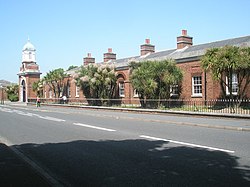
Gosport is a town and non-metropolitan borough, on the south coast of Hampshire, South East England. At the 2021 Census, its population was 81,952. Gosport is situated on a peninsula on the western side of Portsmouth Harbour, opposite the city of Portsmouth, to which it is linked by the Gosport Ferry. Gosport lies south-east of Fareham, to which it is linked by a Bus Rapid Transit route and the A32. Until the last quarter of the 20th century, Gosport was a major naval town associated with the defence and supply infrastructure of His Majesty's Naval Base (HMNB) Portsmouth. As such over the years extensive fortifications were created.
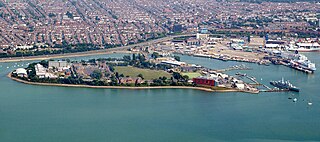
HMS Excellent is a Royal Navy "stone frigate" sited on Whale Island near Portsmouth in Hampshire. HMS Excellent is itself part of the Maritime Warfare School, with a headquarters at HMS Collingwood, although a number of lodger units are resident within the site including the offices of the First Sea Lord.

His Majesty's Naval Base, Portsmouth is one of three operating bases in the United Kingdom for the Royal Navy. Portsmouth Naval Base is part of the city of Portsmouth; it is located on the eastern shore of Portsmouth Harbour, north of the Solent and the Isle of Wight. For centuries it was officially known as HM Dockyard, Portsmouth: as a Royal Dockyard, Portsmouth functioned primarily as a state-owned facility for building, repairing and maintaining warships; for a time it was the largest industrial site in the world.

Gunwharf Quays is a shopping centre located in the Portsea area of the city of Portsmouth in England. It was constructed in the early 21st century on the site of what had once been HM Gunwharf, Portsmouth. This was one of several such facilities which were established around Britain and the Empire by the Board of Ordnance, where cannons, ammunition and other armaments were stored, repaired and serviced ready for use on land or at sea. Later known as HMS Vernon, the military site closed in 1995, and opened to the public as Gunwharf Quays on 28 February 2001 after six years of reconstruction. The landmark Spinnaker Tower, which stands close to the site on pilings in Portsmouth Harbour, was opened on 18 October 2005.

St Vincent College is a co-educational sixth form (16-18) college located in Gosport, Hampshire, England. The majority of students come from the surrounding towns including Gosport, Fareham, Stubbington and Winchester. The nearby Gosport Ferry link with Portsmouth also allows students from that city to attend. The college has around 1,200 full-time students; it also caters for older "Access" students.
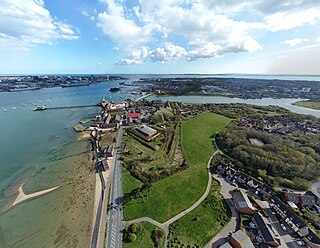
Priddy's Hard is a former military installation in Gosport, England named for the original landowner and the firm beach found there. The site originated as a 1750s fort, and then became an armaments depot for Royal Navy and British Army weapons, explosives and other stores. The site was decommissioned in 1988, after over two hundred years of operation, with part now being developed for housing and an area retained as a museum.
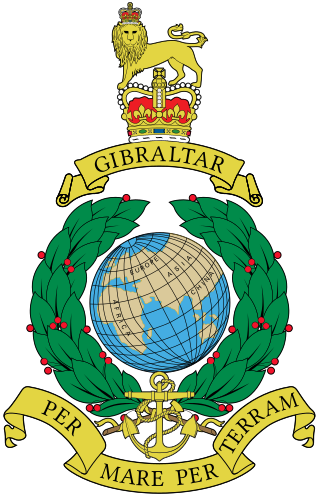
The Royal Marines Band Service is the musical wing of the Royal Navy and an independent element of the Royal Marines. It currently consists of five bands plus a training wing – the Royal Marines School of Music at HMS Nelson – and its headquarters is at HMS Excellent, Whale Island, Portsmouth.

HMS Ceres is a Royal Naval Reserve unit located in Leeds, West Yorkshire.

The Royal Marines Museum is a museum on the history of the Royal Marines from their beginnings in 1664 through to the present day. A registered charity, it is also a designated service museum under the terms of the National Heritage Act 1983 and receives Grant-in-Aid from the Ministry of Defence. During 2011 it formally became part of the National Museum of the Royal Navy, an executive non-departmental public body of the Ministry of Defence. The museum's galleries are currently closed, pending relocation.
The history of the Royal Marines began on 28 October 1664 with the formation of the Duke of York and Albany's Maritime Regiment of Foot soon becoming known as the Admiral's Regiment. During the War of the Spanish Succession the most historic achievement of the Marines was the capture of the mole during the assault on Gibraltar in 1704. On 5 April 1755, His Majesty's Marine Forces, fifty Companies in three Divisions, headquartered at Portsmouth, Chatham and Plymouth, were formed by Order of Council under Admiralty control.
The Royal Marines Volunteer Cadet Corps (RMVCC) is part of the Royal Navy's Volunteer Cadet Corps. There are units (Divisions) in Arbroath, Chivenor, Gosport, Lympstone, Portsmouth, and Plymouth.
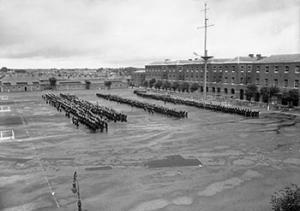
HMS St Vincent was a shore establishment of the Royal Navy, located in Gosport, Hampshire.

Stonehouse Barracks, or RM Stonehouse, is a military installation at Stonehouse, Plymouth. It is the home of 3 Commando Brigade and referred to by commandos as 'the spiritual home of the Royal Marines'.

Eastney Barracks was a military installation occupied by the Royal Marines and located at Eastney near Portsmouth.

The Royal Marine Depot, Deal was a military installation occupied by the Royal Marines and located in an area between Lower Walmer and South Deal in Kent. The Depot was first established in 1861, occupying part of the Royal Naval Hospital. In 1868 the Depot expanded and took over the nearby 18th-century Army barracks. Initially referred to as the Royal Marine Depot, Walmer, by the 20th century it was listed as the Royal Marine Depot, Deal.

Hilsea Barracks was a military installation at Hilsea in Portsmouth.
The Volunteer Cadet Corps (VCC) is a national youth organisation managed by the United Kingdom's Royal Navy and sponsored by the UK's Ministry of Defence. The VCC comprises:

St George Barracks was a military installation at Gosport, Hampshire. In addition to the guard house, barrack blocks, the sergeant's mess and the gymnasium all survive and are Grade II listed buildings.

Clarence Barracks was a military installation at Portsmouth, Hampshire.
